Knee Pain Tennis Players deal with some pretty unique knee challenges. Quick direction changes and explosive moves put a lot of stress on these joints.
Knee Pain Tennis Players are frequently challenged by the demands of their sport, leading to unique injuries that can be prevented with proper techniques.
Knee Pain Tennis Players often experience forces during serves and forehands that can reach over four times their body weight. No wonder knee injuries are so common, whether you play for fun or at a high level.
For Knee Pain Tennis Players, understanding the impact of rapid movements is crucial, as they often lead to injuries not seen in other sports.

The good news? Targeted strength training can really help reduce knee pain and lower your risk of injury. Adding specific leg exercises for tennis into your routine builds up the muscles around your knees and boosts joint stability.
To help Knee Pain Tennis Players, targeted strength training is essential in preventing injuries.
Knowing which exercises actually work—and how to do them right—can mean the difference between playing in pain and enjoying the game. With the right mix of strengthening, stretching, and smart training, your knees get more resilient and you stay on the court longer.
With proper guidance, many Knee Pain Tennis Players can overcome their injuries and improve their performance.
Key Takeaways
- Strength training that targets the muscles around your knees can ease pain and help prevent tennis injuries.
- Good technique and slow, steady progress are crucial for building knee stability safely.
- Mixing strength work with stretching and rest gives you the best shot at long-term knee health.
Understanding Knee Pain Tennis Players: Common Causes and Solutions
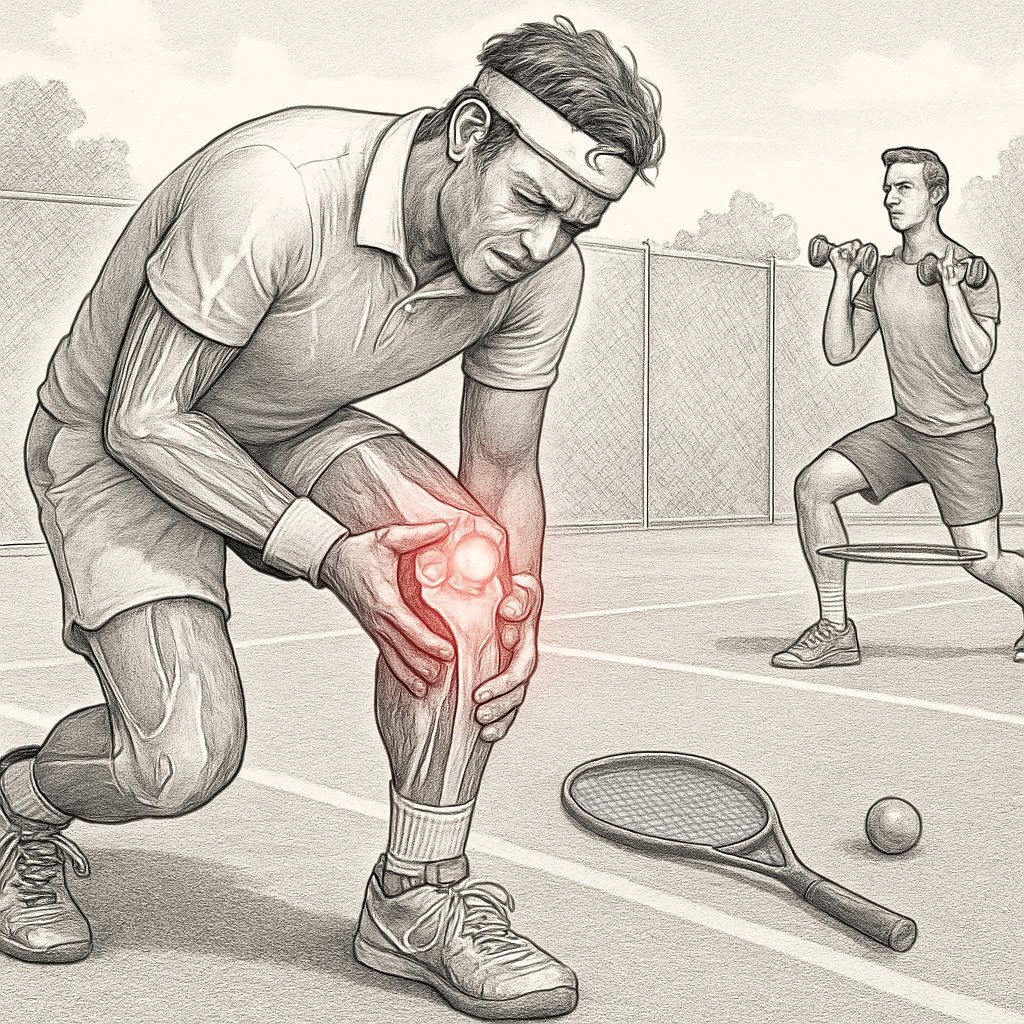
Knee Pain Tennis Players put their knees through a lot with all the demanding moves and repetitive stress. Knee pain from tennis often comes from irritation, inflammation, or strain inside the joint, mostly thanks to the sport’s physical demands.
Knee Pain Tennis Players often face joint issues that stem from the sport’s intense physicality and can benefit from preventive strategies.
Common Knee Injuries on the Court
Three main knee injuries tend to show up in tennis players and can really mess with your game and training.
Patellar tendonitis, or jumper’s knee, hits the tendon connecting your kneecap to your shinbone. It usually shows up after lots of jumping and landing—think serves and volleys.
Runner’s knee (patellofemoral pain syndrome) causes pain around your kneecap. It happens when your kneecap doesn’t track right in its groove while you move.
Meniscus tears come from damage to the cartilage cushioning your knee. Sudden twists or pivots—pretty common in tennis—are usually to blame.
| Injury Type | Primary Symptoms | Common Causes |
|---|---|---|
| Patellar Tendonitis | Pain below kneecap, stiffness | Jumping, landing motions |
| Runner’s Knee | Pain around kneecap | Poor tracking, overuse |
| Meniscus Tears | Clicking, locking, swelling | Twisting, pivoting |
Risk factors unique to Knee Pain Tennis Players bring their own set of challenges, making knee injuries more likely than in some other sports.
Recognizing the specific risk factors for Knee Pain Tennis Players is essential for maintaining their health.
Tennis brings its own set of risk factors, making knee injuries more likely than in some other sports.
Improper knee tracking is a big one. Your knees are constantly dealing with direction changes as you move laterally across the court.
Court surface matters more than you might think. Hard courts hit your knees with more impact than clay does.
How often you play and how hard you train also make a difference. If you skip recovery, you’re asking for overuse injuries.
Poor biomechanics during serves, returns, and movement can load your knees in all the wrong ways. Lateral moves, overuse, and bad form are common culprits behind medial knee pain for tennis players.
Impact of Osteoarthritis on Performance
Osteoarthritis can really affect how you play tennis. Joint degeneration and less mobility are tough to work around.
Joint stiffness limits your range, making it harder to chase low shots or lunge deep. Usually, stiffness gets better with movement but sneaks back after you play.
Pain levels can swing a lot during matches and practice. Cold days and long sessions often make things worse.
Shock absorption drops as cartilage wears down, so the tissues around your knee take more of a beating during high-impact moves.
Movement compensations happen when you change your technique—often without thinking—to dodge pain. That can set you up for injuries elsewhere.
You might have to tweak your playing schedule when flare-ups hit. Some players do better by mixing high- and low-intensity days.
Strength training principles for Knee Pain Tennis Players must be implemented to ensure they can handle the demands of their sport.
Implementing sound training principles will ensure that Knee Pain Tennis Players remain competitive and injury-free.
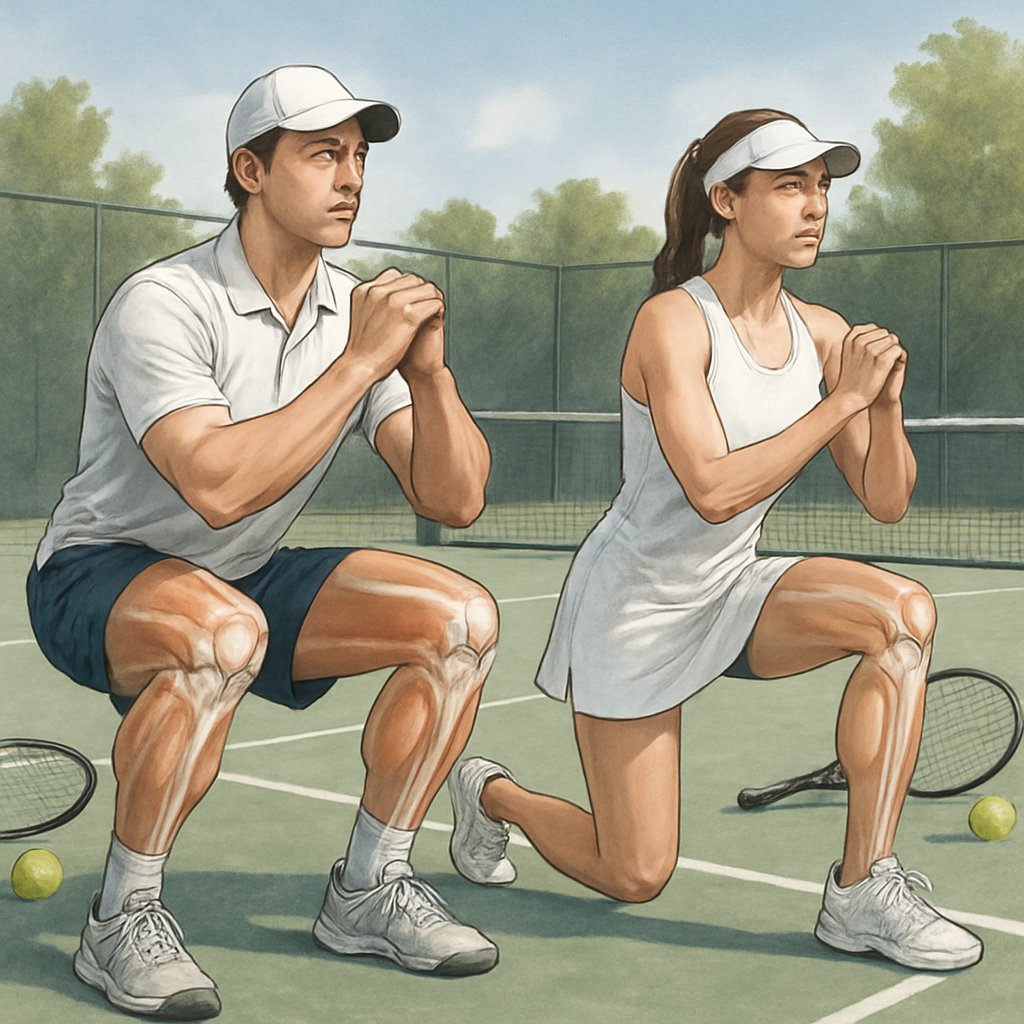
Strong muscles around your knees help protect against injuries and boost your performance on the court. Power and good movement patterns are the backbone of any solid knee protection plan for tennis players.
Role of Strength Training in Injury Prevention
Strength training acts like a shield for your knees. Strong quads, hamstrings, and glutes stabilize your knee whenever you change direction fast.
Proper technique, strength, and conditioning are crucial to prevent knee injuries in tennis. Your muscles soak up impact during landings and quick cuts.
If your muscles are weak, your knees end up taking on stress they’re not built for. That’s how overuse injuries and sudden traumas sneak in.
Key muscle groups for knee protection:
- Quadriceps (front of thigh)
- Hamstrings (back of thigh)
- Glutes (buttocks)
- Calves (lower leg)
Regular strength training can cut your injury risk by half. It also helps you bounce back faster after matches and practices.
Fundamental Movement Patterns
Your knees rely on you mastering basic movement patterns. These mimic what you do in real matches.
Essential movement patterns include:
- Squatting
- Lunging
- Single-leg balance
- Lateral stepping
Squats target your quads and glutes, crucial for Knee Pain Tennis Players. Improving your squat often translates to a better serve, since the muscle timing is similar.
Lunges get your legs ready for moving forward and backward, which happens all the time in tennis. Single-leg work boosts your balance and stability when you’re on the move.
Lateral movements train the muscles that control side-to-side motion. That helps take pressure off your knees when you cover the court quickly.
Start with bodyweight exercises. Nail your form before you add weights or make things harder.
Importance of Power and Speed
Power is all about mixing strength with speed to create explosive moves. Tennis players need this for serves, quick starts, and sudden stops.
Training three to five days a week is usually enough to build strength and power. Focus on exercises that make your legs explosive.
Power training makes your knees safer by teaching your body to absorb landing forces better. Quick muscle contractions help you change direction without overloading your joints.
Power exercises for tennis players:
- Jump squats
- Lateral bounds
- Single-leg hops
- Plyometric lunges
Speed training gets your muscles firing quickly. That fast activation protects your knees during unexpected moves on the court.
Your nervous system learns to coordinate muscle contractions more smoothly. That means fewer awkward moves that could hurt your knee.
Effective training programs are key for Knee Pain Tennis Players to enhance their athletic performance.
Top Strength Training Exercises for Knee Pain
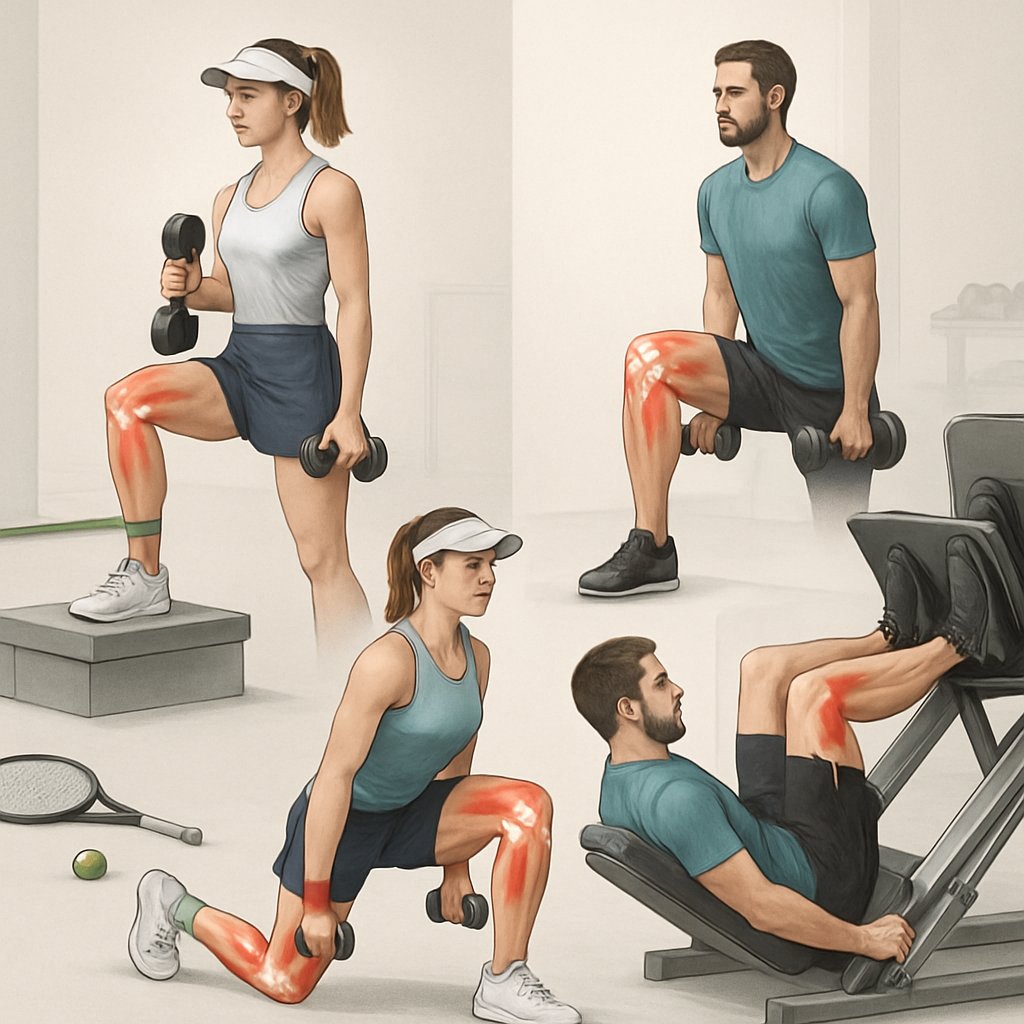
Building knee strength is vital for Knee Pain Tennis Players, focusing on the muscles that stabilize and support their joints during tennis. Progressive strengthening not only reduces pain but also improves power and speed on the court.
Specialized exercises can significantly benefit Knee Pain Tennis Players in recovery and performance.
Lower Body Strengthening
Your quads, hamstrings, and glutes are the main players when it comes to knee stability. They absorb impact from jumps and fuel those fast direction changes.
Wall sits build quad strength without stressing your knees. Just lean against a wall, slide down until your thighs are parallel to the floor, and hold for 30 to 60 seconds.
Step-ups hit several muscle groups and mimic tennis movements. Use a sturdy platform about 6–8 inches high. Step up with one foot, then lower back down slowly. Try 10–15 reps per leg.
Romanian deadlifts work your hamstrings and glutes. Keep a slight bend in your knees, hinge at the hips, lower the weight until you feel a stretch, then come back up.
Glute bridges fire up your backside muscles. Lie on your back, knees bent, and squeeze your glutes to lift your hips. Hold for a couple of seconds at the top.
Core and Balance Workouts
A strong core helps you transfer power between your upper and lower body during shots. Balance training keeps you steady on uneven or slippery courts.
Single-leg stands test your balance and strengthen the stabilizers around your knee. Stand on one foot for 30 seconds, then switch. Want a challenge? Try it with your eyes closed.
Planks build core endurance for those long rallies. Hold a straight line from head to heels for 30 to 60 seconds. Side planks add some lateral stability work, too.
Clamshells target your hip abductors, which help control knee alignment when you move sideways. Lie on your side, knees bent, and lift your top knee while your feet stay together.
Dead bugs improve core stability and coordination. Lie on your back, arms up, and lower opposite arm and leg at the same time while keeping your back flat.
Plyometric and Explosive Movements
Plyometric exercises get your knees ready for the explosive moves tennis demands. They also help build speed and power.
Start simple before you try more advanced plyometric drills.
Box step-downs teach you to control the way your knee absorbs force. Stand on a low box, lower one foot slowly to the ground, and really focus on the descent—not how fast you go.
Lateral bounds mimic the side-to-side action you see constantly on the court. Jump sideways from one foot to the other and try to land softly with your knees bent.
Begin with small jumps, then go for more distance as you get comfortable.
Jump squats build explosive power for those quick starts and changes of direction. Do a regular squat, but then push off and jump up.
Land gently with bent knees to cushion the impact.
Take it slow with plyometrics so you don’t overload your knees. Start out with 2-3 sets of 5-8 reps, and only add more when you feel stronger.
Supplementary Strategies for Knee Protection
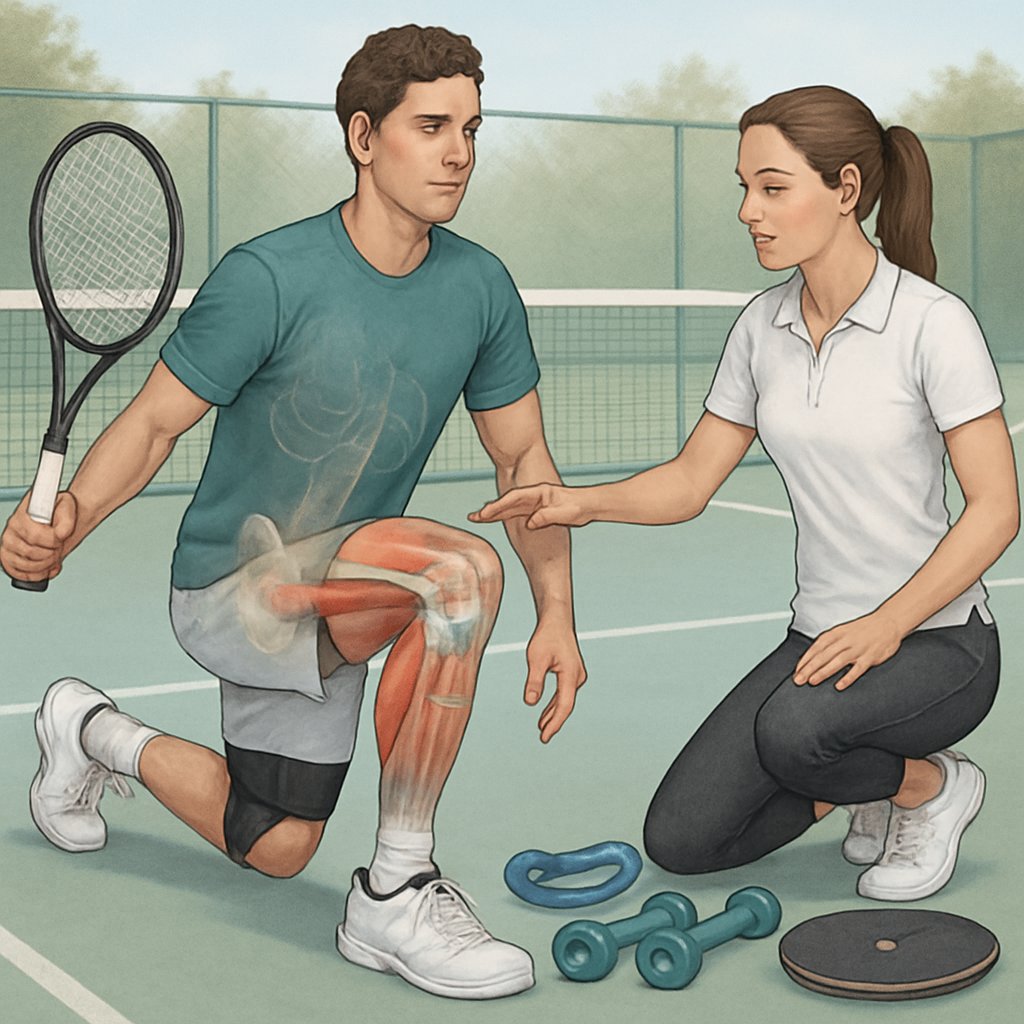
Preparation and recovery routines work with strength training to keep your knees in good shape. Smart equipment and flexibility work add extra layers of protection during play.
Warm-Up and Cool-Down Routines
Your knees need time to warm up before you hit the court hard. A good warm-up gets blood moving and preps your joints for action.
Start with 5-10 minutes of easy jogging or cycling. This gets your body temp up and your knee joints ready.
Creating a tailored warm-up for Knee Pain Tennis Players can prevent injuries during their sessions.
Dynamic warm-up movements:
- Leg swings (forward/backward and side to side)
- Walking lunges with rotation
- High knees and butt kicks
- Lateral shuffles
- Mini tennis swings while moving
These moves get your knees and muscles ready for tennis without going full speed. They also help loosen you up and improve your range of motion.
After playing, cool down to ease muscle tension. Walk slowly for 5 minutes right after your match to help flush out waste and keep stiffness away.
During cool-down, try light static stretches to stay flexible. Focus on your quads, hamstrings, and calves for knee support.
Stretching for Flexibility
Tight muscles around your knees can throw off your balance and cause injuries. Stretching regularly keeps your legs loose and eases stress on your joints.
Key stretches for tennis players:
| Muscle Group | Stretch | Hold Time |
|---|---|---|
| Quadriceps | Standing quad stretch | 30 seconds |
| Hamstrings | Seated forward fold | 30 seconds |
| Calves | Wall calf stretch | 30 seconds |
| IT Band | Cross-leg stretch | 30 seconds |
| Hip flexors | Lunge stretch | 30 seconds |
Make stretching a daily habit, not just something you do on tennis days. Stretching in the morning wakes up your body, and doing it at night can help you recover.
Physical therapists often suggest specific stretches based on your needs. If your knees keep hurting, see a PT who can spot tight areas causing trouble.
Hold each stretch steady—don’t bounce. Take deep breaths and let yourself relax. If you feel sharp pain, stop right away.
Knee Pain Tennis Players should focus on proper stretching techniques to maintain flexibility.
Use of Bracing and Support
Knee braces give you extra stability on the court. They’re most effective when you combine them with strength training and good technique.
Types of knee support:
- Patellar straps take pressure off the kneecap tendon
- Compression sleeves boost circulation and add mild support
- Hinged braces give the most stability for old injuries
Pick braces based on what your knees need. If you have patellar tendonitis, go for straps under the kneecap. If ligaments are an issue, you might need a hinged brace.
Ask an orthopaedic surgeon before using stiff braces. They’ll know if bracing fits your injury and activity level.
Good tennis shoes are your first line of defense for knee health. Swap them out every 45-60 hours of court time or when you notice the tread wearing down.
Look for shoes with strong side support and plenty of cushion. Hard courts demand more shock absorption than clay, so choose accordingly.
Proper shoe features:
- Firm heel counter
- Enough arch support
- Non-slip outsole made for tennis
- Roomy toe box but not too loose
Custom orthotics can help if foot problems throw off your knee alignment. A sports medicine pro can tell you if orthotics are worth trying.
Professional Guidance and Rehabilitation Options
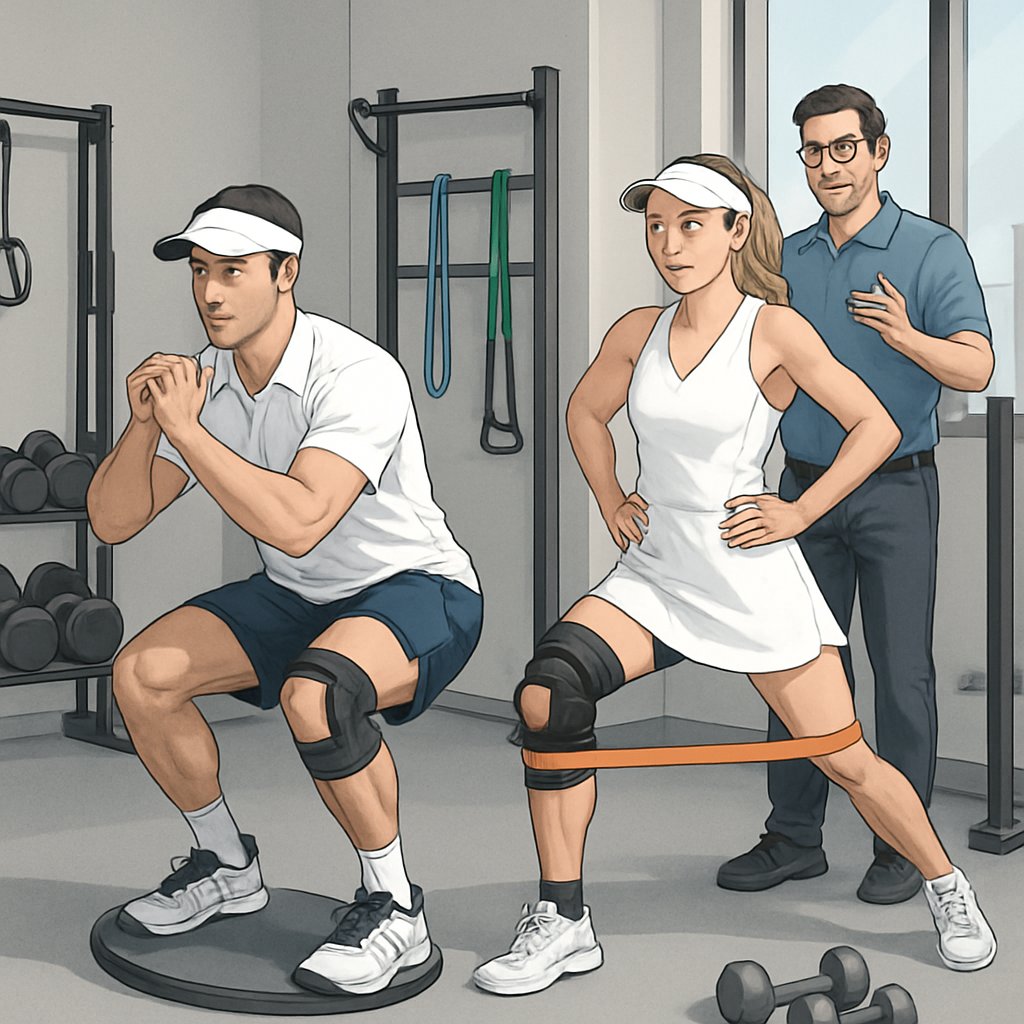
Getting help from a pro can speed up recovery for Knee Pain Tennis Players and cut their risk for future knee trouble. Physical therapy strengthens the muscles around your knee, while orthopaedic surgeons handle the more serious stuff.
Seeking professional guidance is often necessary for Knee Pain Tennis Players to ensure they heal properly.
Role of Physical Therapy in Recovery
Physical therapy is key for treating knee pain in tennis players. A physical therapist will check out your injury and build a plan just for you.
Physical therapy often targets the muscles around your knee. This can ease pain and help your knee move better on the court.
Your therapist will walk you through exercises for different muscle groups, like:
- Quadriceps strengthening – Front thigh muscles that support your kneecap
- Hamstring work – Back thigh muscles that balance knee forces
- Glute activation – Hip muscles that guide leg alignment
- Calf strengthening – Lower leg muscles for push-off power
They’ll also check your movement patterns. Therapists watch how you move and help you fix habits that stress your knees.
Stick with therapy and you might see results in 6-8 weeks. Your therapist will tweak your plan as you get stronger.
When to Consult an Orthopaedic Surgeon
See an orthopaedic surgeon if basic treatment isn’t helping or your injury seems serious. Some warning signs mean you should get checked out quickly.
See a surgeon right away if you notice:
- Your knee gives out completely
- Major swelling that doesn’t improve after two days
- You can’t put weight on your leg
- Your knee looks oddly shaped or deformed
Think about surgery after 6-12 weeks if:
- Pain sticks around even with therapy
- You can’t play tennis without real pain
- Your knee still feels unstable day to day
An orthopaedic surgeon might order scans like MRIs to see what’s going on inside your knee. These images show details of your ligaments and cartilage.
The surgeon will walk you through your options. A lot of knee issues in tennis players still get better without surgery, thanks to newer treatments.
Return-to-Play Considerations
The return-to-play process for Knee Pain Tennis Players must be carefully managed to avoid re-injury.
Getting back on the court takes patience and planning. Tennis players should get a full movement check before returning to play.
Your comeback should go step by step:
Phase 1: Basic Movement (Weeks 1-2)
- Walk pain-free
- Do basic knee exercises
- Regain full range of motion
Phase 2: Sport-Specific Training (Weeks 3-4)
- Light jogs
- Side-to-side drills
- Practice swings without a ball
Phase 3: Progressive Tennis Activity (Weeks 5-6)
- Hit balls against a wall
- Easy rallies with a partner
- Short practice sessions
You’ll need to pass certain tests before moving to each phase. These check your strength and how well you move.
Effective treatments help tennis players return safely. Don’t rush—coming back too soon often leads to setbacks.
Let your physical therapist or doctor clear you for full tennis. They’ll make sure your knee can handle the demands of real matches.
Frequently Asked Questions
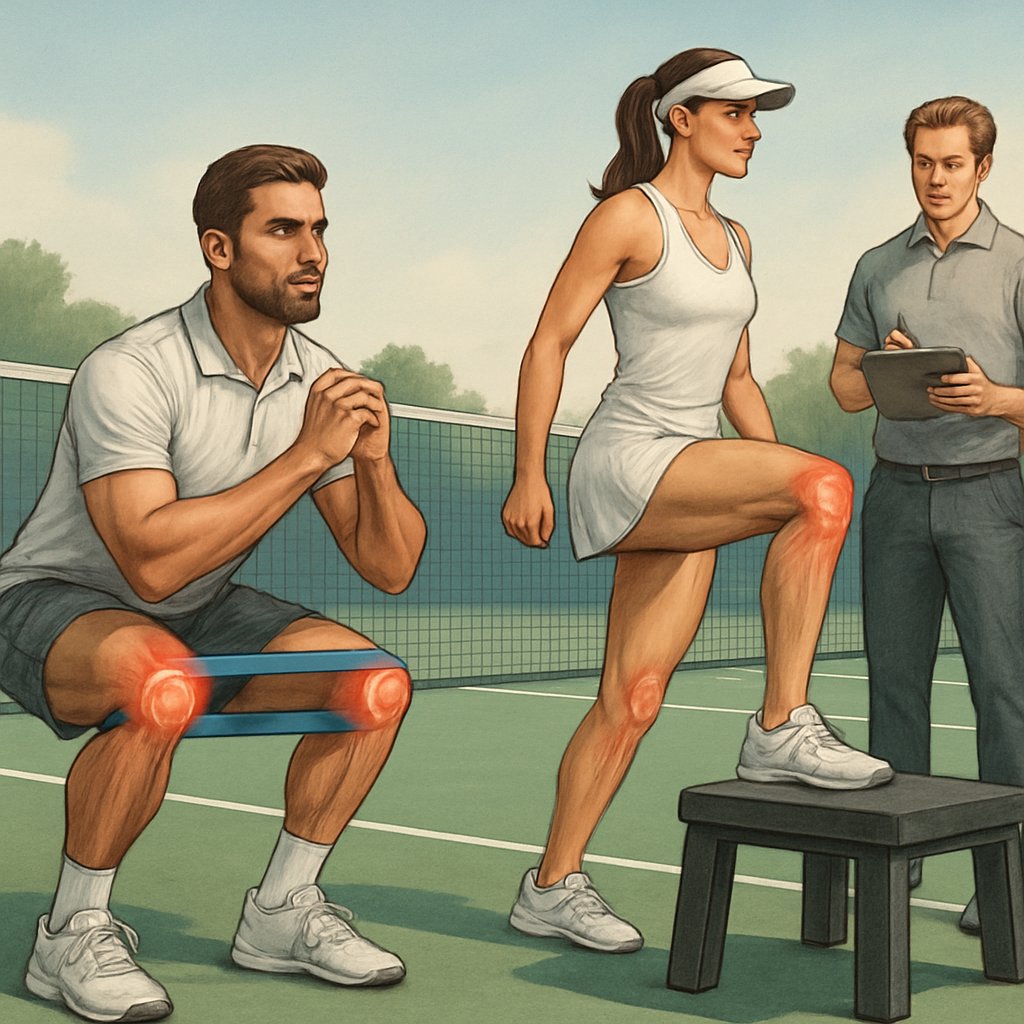
Understanding the needs of Knee Pain Tennis Players is essential for developing effective training programs.
Tennis players need strength training routines that really focus on the muscles supporting the knee. These exercises build stability, cut pain, and help prevent injuries by targeting the right muscle groups.
What are the most effective strength training exercises to alleviate knee pain for tennis players?
Squats and lunges are the bread and butter for knee pain relief in tennis. They work your quads, hamstrings, and glutes all at once.
Single-leg deadlifts challenge your balance and hit those back-of-the-leg muscles. The move even mimics the one-sided actions you do on court.
Step-ups on a bench or platform build real-world strength. Move slowly both up and down to get the most out of each rep.
Knee Pain Tennis Players benefit from a well-structured approach to strength training to avoid future injuries.
Calf raises target your lower legs and boost shock absorption. Try them on flat ground and on an incline for extra challenge.
Strengthening glutes, hamstrings, quads, and calves helps fix movement habits that put too much load on your knees.
How can tennis players incorporate strength training to prevent knee injuries?
Knee Pain Tennis Players should start their strength work in the off-season so their body can adjust without match stress. Doing exercises 2-3 times a week on non-tennis days keeps them progressing without overdoing it.
Focus on good form, not heavy weights, especially at first. Moving well is way more important than moving a lot of weight.
As you get stronger, bump up the weight or reps little by little. Small changes help your joints keep up.
Proper technique, strength, and conditioning are crucial for staying injury-free.
What are the best at-home exercises for tennis players with knee pain?
Wall sits are a simple way to build quad endurance anywhere. Hold for 30-60 seconds and you’ll feel the burn.
Glute bridges fire up your backside muscles without stressing your knees. Try single-leg versions when you want more of a challenge.
Clamshells work your hip muscles. Add a resistance band to make them tougher.
Utilizing proper techniques can help Knee Pain Tennis Players recover faster and strengthen their knees.
Straight leg raises hit your quads while you lie down, keeping knee strain low.
Heel slides gently build knee flexibility and work your hamstrings. Start small and increase your range as you get more confident.
Are there non-surgical treatment options for knee pain specifically suited for tennis athletes?
Physical therapy can give you a plan designed for tennis-related knee issues. Therapists usually focus on the movements and stress your sport puts on your knees.
Rest and ice help calm down swelling after tough training. Try icing your knee for 15-20 minutes, a few times a day, especially when things flare up.
Knee Pain Tennis Players should monitor their condition and adjust their training accordingly.
The right treatments for Knee Pain Tennis Players help remodel injured tendons and let them get back on the court with less risk.
The right treatments help remodel injured tendons and let you get back on the court with less risk.
Compression sleeves can support your knee during matches. Just make sure they fit well and don’t cut off your circulation.
How often should tennis players perform knee strengthening exercises?
Most players see results doing strengthening exercises two or three times a week. That schedule gives your body a chance to recover.
Try 2-3 sets of 8-15 reps for each exercise. Adjust the reps depending on how strong you feel or what you’re aiming for.
Give yourself about 48 hours of rest between tough sessions. Muscles need that downtime to actually get stronger.
Consistent strength training is proven to aid Knee Pain Tennis Players in maintaining their performance levels.
Stick with your routine for a few weeks. A lot of people start to notice improvement after a month or so.
During tournaments, Knee Pain Tennis Players should consider lighter maintenance workouts. They can back off the intensity but still keep their body moving and ready.
What precautions should be taken when doing strength training with pre-existing knee pain for tennis?
If you feel sharp or shooting pain, just stop right away. Dull muscle fatigue happens, but joint pain is a warning sign—don’t ignore it.
Begin with bodyweight exercises. Make sure you nail the form before you start adding any extra weight.
Always warm up thoroughly before strength training. Try some dynamic moves that get your knees ready for action.
Ultimately, Knee Pain Tennis Players must ensure they are mindful of their body’s signals to prevent injuries.
If deep squats or lunges hurt, skip them. Adjust how far you go so you stay comfortable.
Consider working with a trainer or physical therapist at first. Having a professional watch your form can make all the difference.
